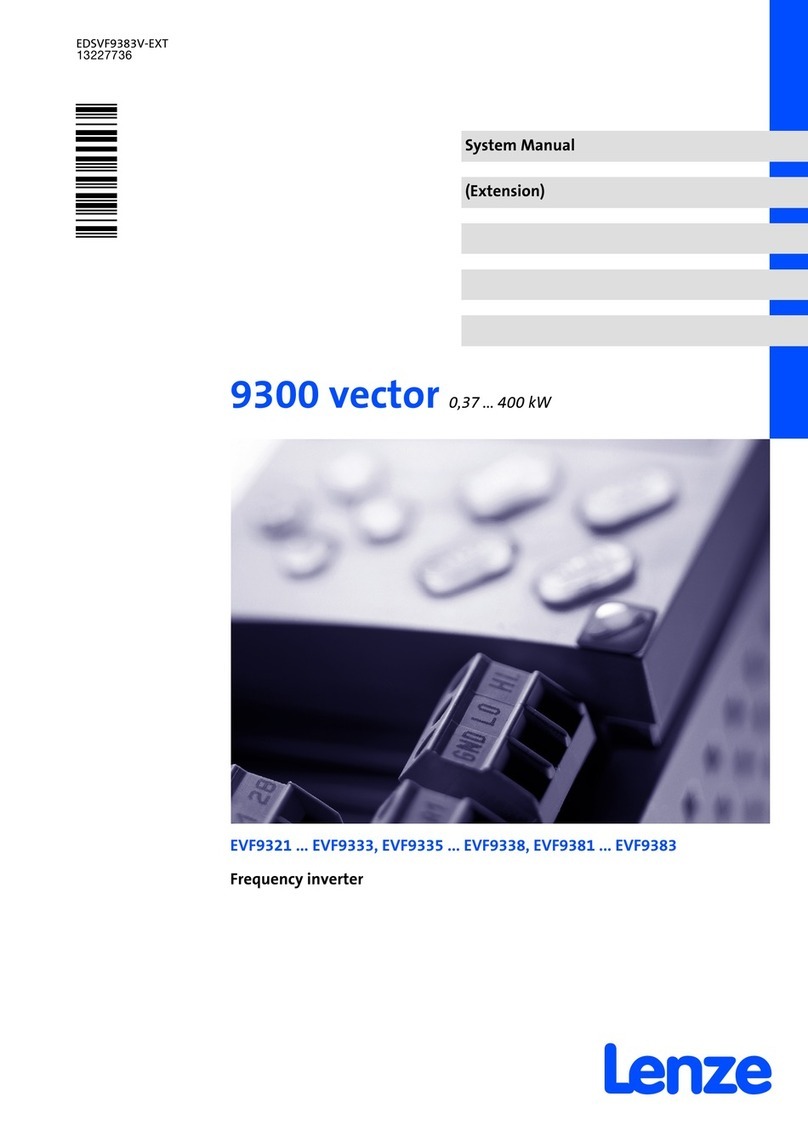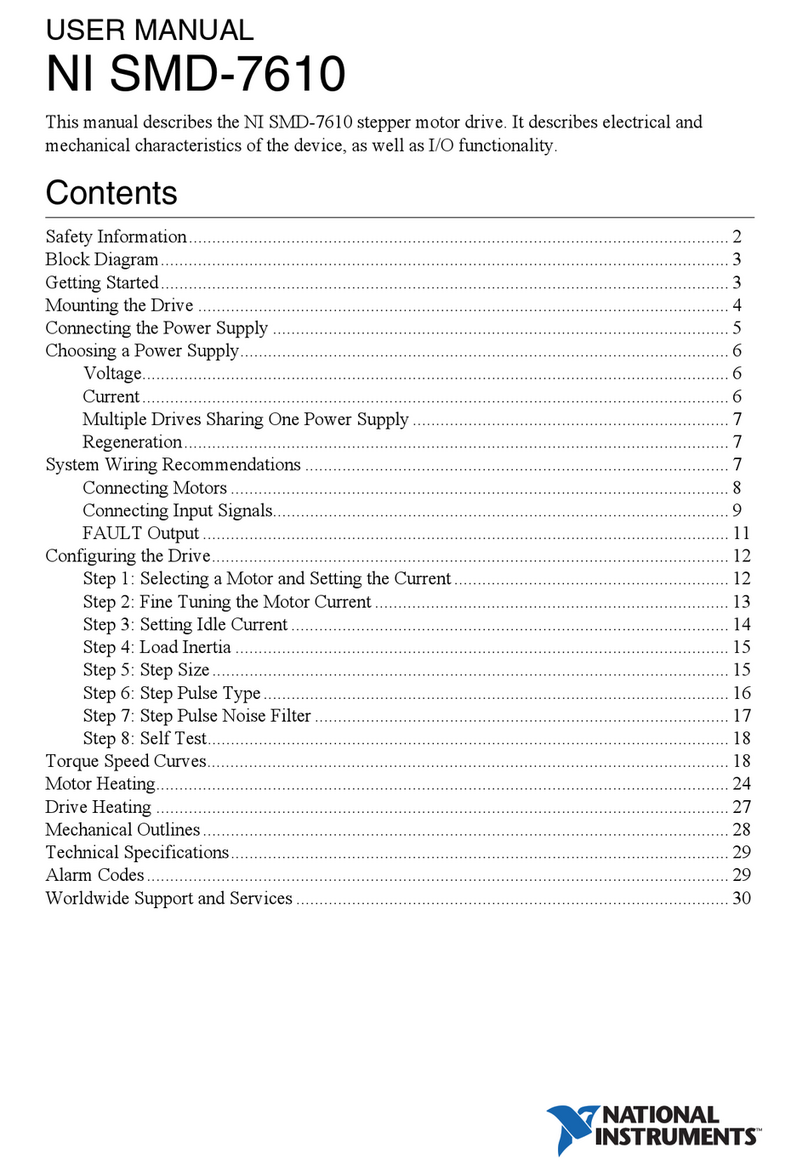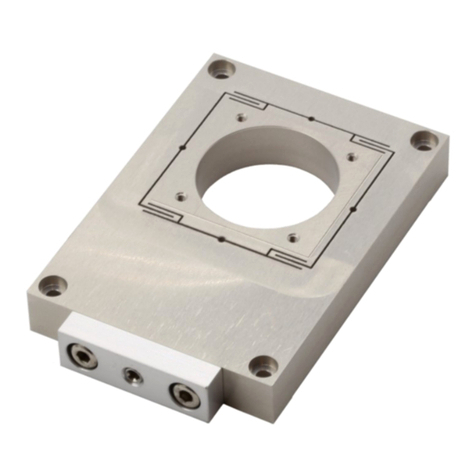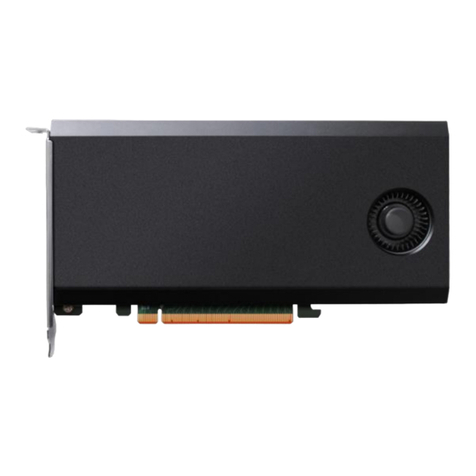Getriebebau NORD NORDAC SK 530E Operating instructions

Supplementary operating instructions
NORDAC SK 530E Frequency Inverter
with positioning control (PosiCon special extension unit)
BU 0510 EN
Getriebebau NORD
GmbH & Co. KG

NORDAC SK 530E with PosiCon function
2 BU 0510 EN
NORDAC Inverter
Safety and operating instructions
for the drive power converter
(as per: Low voltage directive 73/23/EEC )
1. General
During operation, drive power converters may have, depending on
their protection class, live, bare, moving or rotating parts or hot
surfaces.
Unauthorised removal of covers, improper use, incorrect
installation or operation leads to the risk of serious personal injury
or material damage.
Further information can be found in this
documentation.
All transportation, installation and initialisation and maintenance
work must be carried out by qualified personnel (comply with IEC
364, CENELEC HD 384, DIN VDE 0100, IEC 664 and DIN VDE
0110, and national accident prevention regulations).
For the purposes of these basic safety instructions, qualified
personnel are persons who are familiar with the erection,
installation, commissioning and operation of this product and who
have the relevant qualifications for their work.
2. Intended use
Drive power converters are components intended for installation in
electrical systems or machines.
When being installed in machines, the drive power converter
cannot be commissioned (i.e. implementation of the proper use)
until it has been ensured that the machine meets the provisions of
the EC directive 89/392/EEC (machine directive); EN 60204 must
also be complied with.
Commissioning (i.e. implementation of the proper use) is only
permitted when the EMC directive (89/336/EEC) is complied with.
The drive power converters meet the requirements of the low
voltage directive 73/23/EEC. The harmonised standards in prEN
50178/DIN VDE 0160, together with EN 60439-1/VDE 0660 Part
500 and EN 60146/VDE 0558 were applied for the drive power
converter.
Technical data and information for connection conditions can be
found on the rating plate and in the documentation, and must be
complied with.
3. Transport, storage
Information regarding transport, storage and correct handling must
be complied with.
4. Erection
The installation and cooling of the equipment must be
implemented as per the regulations in the corresponding
documentation.
The drive power converter must be protected against unpermitted
loads. During transport and handling in particular, components
must not be deformed and/or insulation distances must not be
changed. Touching of electronic components and contacts must
be avoided.
Drive power converters have electrostatically sensitive
components that can be easily damaged by incorrect handling.
Electrical components must not be mechanically damaged or
destroyed (this may cause a health hazard!).
5. Electrical connection
When working on live drive power converters, the applicable
national accident prevention regulations must be complied with
(e.g. VBG 4).
The electrical installation must be implemented as per the
applicable regulations (e.g. cable cross-section, fuses, ground lead
connections) . Further instructions can be found in the
documentation.
Information about EMC-compliant installation – such as shielding,
earthing, location of filters and installation of cables – can be found
in the drive power converter documentation. These instructions
must be complied with even with CE marked drive power
converters. Compliance with the limit values specified in the EMC
regulations is the responsibility of the manufacturer of the system
or machine.
6. Operation
Systems where drive power converters are installed must be
equipped, where necessary, with additional monitoring and
protective equipment as per the applicable safety requirements,
e.g. legislation concerning technical equipment, accident
prevention regulations, etc. Modifications to the drive power
converter using the operating software are permitted.
After the drive power converter is disconnected from the power
supply, live equipment components and power connections should
not be touched immediately because of possible charged
capacitors. Comply with the applicable information signs located
on the drive power converter.
All covers must be kept closed during operation.
7. Maintenance and repairs
The manufacturer documentation must be complied with.
These safety instructions must be kept in a safe place!

NORDAC SK 530E with PosiCon function
BU 0510 EN Subject to technical changes 3
Documentation
Description: BU 0510 EN
Mat. No.: 607 51 01
Device series: SK 530E
Version list
Designation of previous issues SW Status Comment
BU 0510 DE, June 2007
Mat. No. 607 51 01 / 2307
V. 1.6 R0 First issue
Publisher
Getriebebau NORD GmbH & Co. KG
Rudolf- Diesel- Str. 1 •D-22941 Bargteheide •Germany •http://www.nord.com/
Telephone +49 (0) 45 32 / 401-0 •Fax +49 (0) 45 32 / 401-555
Intended use of the frequency inverter
Compliance with the operating instructions is the requirement for fault-free operation and means
that possible warranty claims will be successful. You must first read these operating instructions
before working with the device!
These operating instructions contain important information about service.They must therefore be
kept close to the device.
The SK 500E/520E/530E frequency inverters are devices for industrial and commercial plants for
operating three-phase asynchronous motors with squirrel-cage rotors. These motors must be suitable
for operation with frequency inverters, other loads must not be connected to the devices.
The frequency inverters SK 500E/520E/530E are devices for stationary installation in control cabinets.
All data regarding technical data and permissible conditions at the installation site must be complied
with.
Commissioning (implementation of the intended use) is not permitted until it has been ensured that the
machine complies with the EMC directive 89/336/EEC and that the conformity of the end product
meets the machine directive 89/392/EEC (note EN 60204).
©Getriebebau NORD GmbH & Co. KG, 2007

NORDAC SK 530E with PosiCon function
4 Subject to technical changes BU 0510 EN
1GENERAL..........................................................................................................................................6
2ENCODER CONNECTION ...............................................................................................................7
2.1 Incremental encoder connection...........................................................................................................7
2.1.1 Colour and contact assignments for the incremental encoder................................................................... 7
2.2 CANopen absolute encoder connection...............................................................................................9
2.2.1 General ........................................................................................................................................................ 9
2.2.2 Authorised CANopen absolute encoders for automatic encoder detection............................................... 9
2.2.3 Assignment of CAN interface in SK 530E ................................................................................................10
3FUNCTION DESCRIPTION ............................................................................................................11
3.1 Introduction............................................................................................................................................11
3.2 Actual position value acquisition........................................................................................................11
3.2.1 Position acquisition with incremental encoder..........................................................................................11
3.2.1.1 Reference point run via digital inputs or BUS I/O In Bits ......................................................... 12
3.2.1.2 Reset Position via digital inputs or BUS I/O In Bits ................................................................. 13
3.2.2 Position acquisition with CANopen absolute encoder..............................................................................13
3.2.2.1 Resetting the CANopen absolute encoder .............................................................................. 14
3.2.2.2 Settings in the CANopen absolute encoder............................................................................. 14
3.2.2.3 Parameterisation in the SK 530E............................................................................................. 15
3.2.2.4 Manual commissioning of the CANopen absolute encoder..................................................... 15
3.2.2.5 Encoder error ........................................................................................................................... 16
3.2.3 Encoder monitoring....................................................................................................................................16
3.2.4 Positioning with absolute/incremental encoders in absolute mode ......................................................... 17
3.2.4.1 Optimal path position during an encoder revolution ............................................................... 17
3.2.4.2 Optimal path position for any encoder revolution .................................................................... 17
3.3 Setpoint specification...........................................................................................................................17
3.3.1 Position array – absolute setpoint position via digital inputs or BUS I/O In Bits......................................17
3.3.2 Position increment array – relative setpoint position via digital inputs or BUS I/O In Bits .............................17
3.3.3 Bus setpoints .............................................................................................................................................17
3.3.4 Bus – absolute setpoint position specification via field bus......................................................................17
3.3.5 Bus increments – relative setpoint specification via field bus ..................................................................17
3.4 Teach-In function via digital inputs or BUS I/O In Bits......................................................................17
3.5 Ratio of setpoint and actual values (P607 and P608)........................................................................17
3.6 Position control functions (P600)........................................................................................................17
3.7 Position control.....................................................................................................................................17
3.8 Output signals .......................................................................................................................................17
3.8.1 Multifunction relays (P434, 441) and digital outputs (P450, P455)..........................................................17
3.8.2 Output signals via Bus I/O In Bits (P481) .................................................................................................17
4PARAMETER SETTINGS...............................................................................................................17
5COMMISSIONING...........................................................................................................................17
6SYNCHRONOUS CONTROL .........................................................................................................17
6.1 General...................................................................................................................................................17
6.2 Communication settings ......................................................................................................................17
6.3 Slave ramp time and maximum frequency settings ..........................................................................17
6.4 Speed control and position control settings......................................................................................17
6.5 Taking into account the ratio between master and slave .................................................................17
6.6 Achievable accuracies / Position monitoring.....................................................................................17
6.7 Significance of P630 for synchronisation...........................................................................................17
6.8 Comments regarding reference point runs during synchronisation...............................................17
6.9 Using offset in synchronous mode.....................................................................................................17
7TROUBLESHOOTING....................................................................................................................17
7.1 Error messages .....................................................................................................................................17

NORDAC SK 530E with PosiCon function Index
BU 0510 EN Subject to technical changes 5
7.2 Table of error sources ..........................................................................................................................17
8REPAIR............................................................................................................................................17
9KEY WORD INDEX / ABBREVIATIONS........................................................................................17
10 KEY WORD INDEX .........................................................................................................................17
11 REPRESENTATIVES / BRANCHES..............................................................................................17

NORDAC SK 530E with PosiCon function
6 Subject to technical changes BU 0510 EN
1 General
NORDAC SK 530E frequency inverters are voltage source frequency inverters with fully digital microprocessor
technology designed to control the speed of three-phase current motors.
In combination with an incremental encoder or absolute encoder, the standard components become a highly
accurate positioning drive:
•The frequency inverter contains 15 programmable absolute positions.
•Position is maintained even through strong load fluctuations thanks to the position control.
•Time optimised and secure travel to the aim thanks to path calculations.
•In addition to travelling to absolute positions, up to 4 incremental settings ( so-called position
increments) can be saved in the frequency inverter.
•Required positions can also be transmitted via a field bus interface.
•The positioning function is available in the SK 530E as a function extension.
The parameters (P6xx) required for positioning are included in the existing inverter menu structure as an additional
menu group (Positioning)
The position setpoint specification can be set via the existing digital inputs, the Bus IO In bits or via the USS
protocol or another field bus system.
Conversion between speed control and position control (positioning) is possible by switching the parameter sets.
Synchronous functionality between a master and one or more slave drives is possible via the integrated CAN
Bus or the RS485 interface.
A rotary axis function (modulo-axes) for turntables and similar applications is also available. This controls a
path-optimised endless axis, depending on the position required the drive rotates left or right.
NOTE :
This description (BU 0510) only contains those functions and parameters specific to and relevant for the positioning
functions. All standard functions and parameters can be found in the manual (BU 0500) accompanying the
frequency inverter.
Due to software updates, it is possible that the parameters described here may vary from those in your device.
You must ensure therefore that both the current NordCon version and the version of your parameter box are
updated to the latest software version. In case of doubt, contact your local NORD representative.
You can always find the latest version of this description on the Getriebebau NORD Internet site:
http://www.nord.com/

NORDAC SK 530E with PosiCon funktion 2 Encoder connection
BU 0510 EN Subject to technical changes 7
2 Encoder connection
2.1 Incremental encoder connection
The incremental encoder connection is an input for a type with two tracks and with TTL-compatible signals for
drivers as per EIA RS 422. The maximum current consumption of the incremental encoder must not exceed
150mA. The voltage supply for the incremental encoder is 10-30 V.
The pulse number per revolution can be between 500 and 8192 pulses.
It is set via the parameter P310 "Incremental encoder pulse number" in the menu group "Control parameters". With
cable lengths > 20 m and motor speeds over 1500 min-1, the encoder should not have more than 2048
pulses/revolution.
If the cable is longer, the cable cross-section must be selected large enough to ensure that the voltage drop across
the cables is not too high. The supply cable in particular is affected by this, the cross-section can be increased by
parallel switching of several wires.
2.1.1 Colour and contact assignments for the incremental encoder
Operating principle Cable colours for incremental
encoder Assignment for SK 530E
10-30V supply brown / green X5.42 VO +15V
0V supply white / green X6.40 DGND
Track A brown X6.51 ENC A+
Track A inverse green X6.52 ENC A-
Track B Gray X6.53 ENC B+
Track B inverse pink X6.54 ENC B-
Track 0 red --
Track 0 inverse black --
Cable shield Ground extensively via the strain relief or shield angle (can be ordered as
fastening kit option)
NOTE : If there are deviations from the standard equipment (10-30V encoder, TTL/RS422) for the
motors, please note the accompanying data sheet or consult your suppler.
An external 24V or internal 15V voltage from the frequency inverter can be used as the
voltage supply.
ATTENTION
The rotation of the incremental encoder must correspond to that of the motor. Therefore,
depending on the rotation direction of the encoder to the motor (possibly reversed), a
positive or negative pulse number must be set in parameter P301 "Incremental encoder
pulse number".

NORDAC SK 530E with PosiCon function
8 Subject to technical changes BU 0510 EN
Terminal blocks:
X4: analog inputs
and outputs
+10V max. 5mA
0...10V or
0/4...20mA
X5: digital inputs
and voltage
supply
Rica. 4.5kΩ
+15V max. 150mA
+5V max. 250mA
X6: Incremental
encoder input
only with
SK 520E/530E
Encoder, e.g:
10-30V,TTL,RS422
2048Imp./Rev.
Note: 5V encoder
should not
be used.
X7: additional digital inputs
and outputs
only with SK 520E/530E
DIP switch:
Switching from analog
inputs AIN2/AIN1
current/voltage setpoint
I = current 0/4...20mA
V = voltage 0...10V
NOTE :
AIN2 – upper DIP Switch
AIN1 – lower DIP Switch
NOTE :
This description (BU 0510) only contains a selection of functions and connection terminals specific to and relevant
for the positioning functions. All standard functions can be found in the manual (BU 0500) accompanying the
frequency inverter.

NORDAC SK 530E with PosiCon funktion 2 Encoder connection
BU 0510 EN Subject to technical changes 9
2.2 CANopen absolute encoder connection
2.2.1 General
The connection of an absolute encoder to the SK 530E is implemented via the internal CANopen interface. The
absolute encoder to be connected must have, as a minimum requirement, a CAN bus interface with CANopen
protocol. The internal CAN bus with CANopen protocol can be used simultaneously for control and
parameterisation, as well as for reading out the absolute encoder position.
The SK 530E supports CANopen absolute encoders with the communication profile DS 406. If an absolute encoder
authorised by Firma Getriebebau Nord is used, then automatic parameterisation of the encoder via the SK 530E is
possible. The CAN address and baud rate of the encoder must be set at the encoder using the rotary or dip switch
All other necessary parameters can be set by the SK 530E via the CAN bus in the encoder.
2.2.2 Authorised CANopen absolute encoders for automatic encoder detection
Only the CANopen absolute encoders (with bus cover) from the following companies are authorised:
Company Internet Single turn encoder Multiturn encoder
FRABA
Posital
www.posital.de Authorisation currently not available for
single turn encoder
Where necessary upon request
Optical-mechanical encoder
Type: OCD-C2X1B-XXXX-XXXX-0CC
10-30V DC, 25Bit
8192 Inc/rev, 4096 rev
IVO www.ivo.de Authorisation currently not available for
single turn encoder
Where necessary upon request
Magnetic encoder
Type: Multivo GOMMH.X205P32
10-30V DC, 29Bit
Default: Node ID 1, 50KBd
Parameterisable
Fritz Kübler www.kuebler.com Optical-mechanical encoder
Type:
Sendix 8.5878.XX2X.XXXX.XXXXX
Optical-mechanical encoder
Type:
Sendix 8.5888. XX2X.XXXX.XXXXX
10-30V DC

NORDAC SK 530E with PosiCon function
10 Subject to technical changes BU 0510 EN
2.2.3 Assignment of CAN interface in SK 530E
The 24V supply for the absolute encoder and for the CAN-Bus/CANopen interfaces must be implemented via an
external voltage supply. For the terminal assignment please refer to the operating instructions of the encoder
manufacturer.
RECOMMENDATION: We recommend the use of an RJ-45 transfer module for the connection of the 24V
voltage supply.
Supplier Designation Part no.
WAGO Kontakttechnik
GmbH
Ethernet connection module with CAGE-CLAMP
connection
Transfer module RJ-45
289-175
WAGO Kontakttechnik
GmbH
Accessories:
WAGO shield U-bolt 790-108
DIP switch and plug block 2xRJ45, CAN bus (SK 520E/530E only)
1 CAN_H
2 CAN_L CAN bus Signal
3 CAN_GND CAN bus GND
4 nc
5 nc No function
6 CAN_SHD Cable shield
7 CAN_GND GND /0V
8 CAN_24V Ext. 24VDC +/- 25%
voltage supply
(capacity, min. 30mA)
Max. baud rate
…500kBaud
1 2
ON
DIP switch 2
for CAN bus
Termination resistor
R=120Ω
CAN_H
CAN_L
CAN_GND
nc
CAN_SHLD
CAN_GND
nc
CAN_24V
CAN_H
CAN_L
CAN_GND
nc
CAN_SHLD
CAN_GND
nc
CAN_24V
RJ45: Pin No. 1 … 8
For SK 520E/530E:
CAN interface, two RJ45
connectors, the bus
termination resistor can be
connected

NORDAC SK 530E with PosiCon funktion 3 Function description
BU 0510 EN Subject to technical changes 11
3 Function description
3.1 Introduction
Numerous positioning and position control tasks can be resolved with the positioning function. To facilitate the
decision about which configuration the task can be best resolved with, the various methods for setpoint
specification and actual value acquisition are presented below.
The setpoint specification can be provided as an absolute or relative position. An absolute position specification is
recommend for applications with fixed positions, for instance with transfer carriages, elevators, shelf access
equipment, etc. The relative position specifications are suitable for all axes operating incrementally, especially for
endless axes such as rotary tables and cycled compartmented conveyor belts. The setpoint specification can also
be implemented via bus (Profibus, CAN bus, Interbus, DeviceNet or USS interface). The position can be specified
here as value or bit combination as position number or increment.
If there is need to change between positioning and speed specification, this can be implemented via parameter
switching. To do this, the position control in parameter P600 "Position control" is parameterised to "ON" in one
parameter set and "OFF" in another parameter set. The parameter sets can be switched at any time, including
during operation.
3.2 Actual position value acquisition
3.2.1 Position acquisition with incremental encoder
A reference point is required for an absolute actual position, this helps to determine the zero position of the axis.
The position acquisition works as long as the frequency inverter is supplied with voltage. The impulses of the
incremental encoder are counted in the inverter and added to the actual position value. Parameter P301
"Incremental encoder pulse number“ is used to set the resolution or pulse number of the incremental encoder. The
rotation direction can be adapted according to the installation position of the encoder by using negative pulse
numbers. After switching on the inverter voltage supply, the actual position = 0 (P604 "Encoder type" without the
option "Save position") or it is set at the value present during switch-off (P604 "Encoder type" with the option "Save
position").
The position acquisition works independently of the inverter enable signal and the parameter P600 "Position
control". The inverter records the actual position as long as it is supplied with voltage. Position changes that are
implemented when the frequency inverter is switched off do not lead to any changes in the actual position. A
reference point run is therefore generally required after every "Mains on".
If the inverter is not operated in servo- mode P300 "Servo mode", the incremental encoder can also be mounted
elsewhere than on the motor shaft. In this case, the ratiofrom the motor to incremental encoder must be
parameterised. The incremental encoder revolutions are converted into motor revolutions in the encoder with the
aid of the parameters P607 "Ratio" and P608 "Reduction ratio“.
n
M: Motor revolution
nM= nG* Üb/ UnnG:: Incremental encoder revolution
Ü
b: Ratio (P607 [01])
Un: Reduction ratio (P608 [01])
Example: The incremental encoder is attached to the gear output side, the gear has a ratio of i = 26.3. The following values are
parameterised:
P607 ratio: 263; P608 reduction ratio: 10
NOTE : The rotation direction of the incremental encoder must correspond to that of the motor. With a
positive output frequency (rotation right), the position actual value must be larger. If the rotation
direction does not correspond, this can be corrected with a negative value in P607 "Ratio".
With the help of a parameterisable value in parameter P609 [01] "Offset position", the zero point can be moved to
another position than the position determined by the reference point. The offset is taken into account after the
conversion of the encoder revolutions into motor revolutions. After changes to the ratio/reduction ratio in P607 [01]
and P608 [01], the offset position value must be entered again.

NORDAC SK 530E with PosiCon function
12 Subject to technical changes BU 0510 EN
3.2.1.1 Reference point run via digital inputs or BUS I/O In Bits
The reference point run is started via one of the 7 digital inputs or one of the Bus IO In Bits. To do this, a digital
input must be programmed to the corresponding function (P420-P425 or P460 "Digital input function", setting 22).
The corresponding Bit / Array (P480 "Bus IO In Bits", setting 22) must be parameterised for the Bus IO In Bits. The
direction of the reference point search is specified by the signal Enable left / right. The actual setpoint frequency
determines the speed of the reference point run. The reference point is also read in via one of the 7 digital inputs.
To do this, a digital input must be programmed to the corresponding function (P420-P425 or P460 "Digital input
function", setting 23). The corresponding Bit / Array (P480 "Bus IO In Bits", setting 23) must be parameterised for
the Bus IO In Bits.
To realise the function "Reference point run" via a serial interface or via the Bus IO In Bits, one of the "Function
Bus-setpoint" (P546, P547 and P548) must be set to the setting 17 "Bus IO In Bits 0..7" and the function setting 22
assigned to the corresponding bit in P480 "Function Bus I/O In Bits".
Sequence of reference point run: When the reference point run is switched on, the drive runs according to the
direction of the setpoint (Enable right/left , +/- setpoint). When the reference point switch is reached, the signal
reverses the run direction at the digital input or Bus IO In Bit "Reference point". The reference switch is therefore
left again. After the switch is left, the reference point run is ended. If the drive is already at the switch at the start of
the reference point run, the reference point run is started immediately with the inverted rotation direction. After the
switch is left, the reference point run is ended and the actual position is set to 0 or to the value set in parameter
P609 "Offset position". The drive remains at the new zero point until the reference point run is ended by removal of
the signal "Reference point run". In the setpoint mode P610 "Position increment array" = 1 (relative positioning), the
setpoint position is also set to 0. The frequency inverter indicates the end of the reference point run with the
acceptance of the reference point when the appropriate parameterisation is implemented in one of the parameters
"Output function" (P434, P441, P450, P455, setting 20 – reference point). The acknowledgement about the end of
the reference point run can also be signalled via the Bus IO Out Bits (P481 "Bus IO Out Bits", setting 20).
If an incremental encoder is used without the function "Save position" (see P604 "Encoder type"), the actual
position in parameter P601 "Actual position" will be set to the value "0" after the frequency inverter is switched on.
When parameterising with the function "Save position", the last saved value is used as the actual position.
The relay or output signal "Reference point" indicates that a valid reference point is present. The relay or the
outputs switch off when a reference point run is started and switch back on after the end of the reference point run.
If the option "Save position" (P604 "Encoder type") is not selected (default setting), the relay or output switches off
after the inverter is switched on.
If the option "Save position" is selected, the relay or output switches on immediately after the inverter is switched
on. Control via one of the Bus IO In Bits is correspondingly identical.
The reference point run can be stopped by removing the "Enable" or through an "Emergency stop" or "Voltage
block".
ATTENTION
In this case, the frequency inverter will not generate an error message!
NOTE: Further details on the setting options for functions can be found in the respective parameter
descriptions in Chapter 4 Parameter settings.

NORDAC SK 530E with PosiCon funktion 3 Function description
BU 0510 EN Subject to technical changes 13
3.2.1.2 Reset Position via digital inputs or BUS I/O In Bits
Alternatively to the reference point run, one of the digital inputs can be programmed to the setting "Reset Position"
(P420-P425 or P470, setting 61). Control via one of the Bus IO In Bits is correspondingly identical. In contrast to
the function reference point , the input or the Bus IO In Bit is always effective and sets the actual position during a
signal change from 0 →1 immediately to 0. If an offset is parameterised in parameter P609 "Offset actual
position", the axis will always travel by this value. The position reset is implemented independently of the setting for
the "Position control" in parameter P600. The setpoint position is set to 0 in the "Setpoint mode" (in parameter
P610, 2 = position increment array).
The repeat accuracy of referencing via the Reset position is not as good as in the reference point run, it depends
on the tolerance of the reference point switch and the speed with which the switch is approached. However, the
achievable accuracy is sufficient for many applications. In addition, referencing can be implemented without
interrupting the position control.
The function "Reset position" can also be realised via a serial interface or the Bus IO In Bits. To do this, one of the
"Bus setpoint values" (P546, P547 and P548) must be set to the setting 17 "Bus IO In Bits 0..7" and the function
setting 61 assigned to the corresponding bit in P480 "Function Bus I/O In Bits".
NOTE: Further details on the setting options for functions can be found in the respective parameter
descriptions in Chapter 4 Parameter settings.
3.2.2 Position acquisition with CANopen absolute encoder
The absolute encoder transmits the position actual value serially via the CANopen interface to the frequency
inverter. The position is always fully present in the absolute encoder and is also correct after the axis is shifted
when the inverter is switched off. There is therefore no need to make a reference point run.
When connecting an absolute encoder, the parameter P604 "Encoder type" must be parameterised to one of the
absolute functions (setting 1, 5, 6 or 7) for the CANopen absolute encoder.
If the absolute encoder is not mounted on the motor shaft, the ratio from motor to absolute encoder must be
parameterised. The absolute encoder revolutions are converted into motor revolutions in the encoder with the aid of
the parameters P607 "Ratio" and P608 "Reduction ratio".
n
M: Motor revolution
nM= nG* Üb/ UnnG:: Absolute value encoder revolution
Ü
b: Ratio (P607 [02])
Un: Reduction ratio (P608 [02])
Example: The incremental encoder is attached to the gear output side, the gear has a ratio of i = 26.3. The following values are
parameterised: Ratio: 263; Reduction ratio: 10
The rotation direction of the absolute encoder must correspond to that of the motor. With a positive output
frequency (rotation right), the position actual value must be larger. If the rotation direction does not correspond, this
can be corrected with a negative value in P607 "Ratio".
The zero point of the axis can be corrected with the help of a parameterisable value in parameter P609 [02] "Offset
position. The offset is taken into account after conversion. After changes to the ratio/reduction ratio in P607 [02]
and P608 [02], the value in parameter P609 "Offset actual position" must be entered again.
ATTENTION
The maximum possible position in parameter P615 "Maximum Position" is based on the
resolution of the encoder and the ratio/reduction ratio (P607 and P608). The maximum value
must in all cases not exceed +/- 65535 (16Bit) revolutions. Exceeding this range is not
allowed. Endless axes that run mainly in one direction must be implemented with an
incremental encoder (see Chapter 3.2). Position setpoints are limited internally to the
maximum possible value range.

NORDAC SK 530E with PosiCon function
14 Subject to technical changes BU 0510 EN
3.2.2.1 Resetting the CANopen absolute encoder
Using the two functions "Reference point run" (see Chapter 3.2.1.1) and "Reset Position" (see Chapter 3.2.1.2), a
CANopen absolute encoder can also be run to the value "0" or the value set in parameter P609 [02] "Offset actual
position".
As resetting the position in the CANopen absolute encoder takes somewhat longer than the resetting of an
incremental encoder, the speed during the resetting procedure should be selected as low as possible, otherwise
greater variances can occur.
If both an incremental encoder and a CANopen absolute encoder are attached to the frequency inverter, both
encoders will be reset when the function "Reference point run" or "Reset position" are carried out.
3.2.2.2 Settings in the CANopen absolute encoder
The baud rate and CAN address must be set in the encoder. For the encoder switch assignments, please refer to
the operating instructions of the manufacturer.
The CAN address for the absolute encoder must be set according to the following formula in parameter P515 "CAN
address":
Encoder CAN address = SK 530E CAN bus address (P515) + 1
The CAN baud rate set in the encoder must be identical to that in the SK 530E parameter P514 "CAN bus baud
rate" and all other participants in the bus system.
If the encoder is parameterised via the SK 530E, the transmission cycle for the absolute encoder position is also
specified via the baud rate.
When operating several CANopen absolute encoders on a bus system, e. g. during synchronous operation,
different transmission cycles can be set for the CAN Master and the CANopen absolute encoders.
The cycle time can be parameterised with the parameter P552 "CAN cycle time" in Array [01] for the
CAN/CANopen master mode and in Array [02] for the CANopen absolute encoders. It must be ensured that the
parameterised values do not undershoot the value in the column minimum value of the actual cycle time. This value
is dependent on the baud rate set in the parameter P514 "CAN baud rate".
P514
Baudrate
[kBaud]
P552 [01]
Default CAN
Master
[ms]
P552 [02]
Default CANopen
absolute encoder
[ms]
P552 [02]
Minimum value for
actual cycle time
[ms]
Bus load caused by
an encoder
[%]
10 50 20 10 42.5
20 25 20 10 21.2
50 10 10 5 17.0
100 5 5 2 17.0
125 5 5 2 13.6
250 5 2 1 17.0
500 5 2 1 8.5
100015 2 1 4.25
Table 1: Cycle time of encoder dependent on baud rate
The possible bus load for the system always depends on the system-specific real time. Very good results are
obtained with a bus load less than 40%. A bus load greater than 80% should not be selected in any case. When
estimating the bus load, the other possible bus traffic (setpoint and actual values for the FI's and other bus
participants) should be taken into account.
Additional information about the CAN interfaces can be found in the manual BU 0060.
1Only for test purposes, safe operation cannot be guaranteed.

NORDAC SK 530E with PosiCon funktion 3 Function description
BU 0510 EN Subject to technical changes 15
3.2.2.3 Parameterisation in the SK 530E
The settings appropriate to the CANopen absolute encoder must be parameterised using the parameters P514
"CAN baud rate" and P515 "CAN address".
ATTENTION
Before the CANopen absolute encoder can be connected to the frequency inverter, the
parameters P514 "CAN baud rate" and P515 "CAN address" must be parameterised!
The following settings should only be implemented when the CAN bus is connected to all devices with a
corresponding 24V voltage supply.
The resolution of the absolute encoder is set via the parameter P605 "Absolute encoder".
P605 [01] = Multiturn resolution in Bit
P605 [02] = Single turn resolution in Bit
The settings to be made can be found in the data sheet of the absolute encoder.
Example: for a 25 Bit encoder (12 Bit multiturn, 13 Bit single turn):
P605 [01] = 12 Æ4096 number of resolvable encoder revolutions
P605 [02] = 13 Æ8192 resolution per encoder revolution
The CAN absolute encoder is activated via the parameter P604 "Encoder type". The following settings are possible:
P604 = 1 ÆCANopen absolute encoder (Auto), active with automatic configuration
P604 = 6 ÆCANopen absolute encoder (Manual), active with manual configuration
The encoder can be used for the function "Optimal path" with the following settings:
P604 = 5 ÆCANopen absolute encoder optimal path (Auto), active with automatic configuration
P604 = 7 ÆCANopen absolute encoder optimal path (Manual), active with manual configuration
In the function "Optimal path", the multiturn resolution of the encoder for the overrun point can be additionally
limited with the parameter P615 "Maximum position". The multiturn resolution is entered in parameter P615 in
revolutions (1 revolution = 1.000 rev). It is also possible to set an "odd" number of revolutions. For an example, see
Chapter 3.2.4.2.
After setting or selecting the encoder type in parameter P604 "Encoder type", the function of the encoder can be
checked using the parameter P601 "Actual position".
ATTENTION
Only NORD approved encoder types, see Chapter 2.2.2, can be used for the function
"Automatic configuration"!
3.2.2.4 Manual commissioning of the CANopen absolute encoder
In addition to "automatic" configuration (Auto), a "manual" setting (Manual) is also possible. In Auto,
parameterisation is implemented by the frequency inverter. For manual commissioning, a CAN bus master is
required in addition to the SK 530E and the encoder. This must be set by the encoder to the bus state
"Operational" and the following parameters must be set.
- Parameter 0x6001 and 0x6002: the resolution
according to the settings in P605 "Absolute encoder"
- Parameter 0x6200: the cycle time
Recommended parameterisation: a value ≤20ms. The selected cycle time influences the reaction time
of the position control in SK 530E.

NORDAC SK 530E with PosiCon function
16 Subject to technical changes BU 0510 EN
3.2.2.5 Encoder error
If a CANopen encoder is parameterised in SK 530E and the position control is switched on in parameter P600
"Position control", the function of the encoder is constantly monitored. If the "Position control" P600 is not switched
on, the encoder is position is displayed but no error messages will be generated if there is a problem. Emergency
or manual operation is therefore always possible.
•If one of the following conditions occur, a malfunction or error message E14.42is triggered:
- There is no contact to the encoder five seconds after the SK 530E is switched on
- The encoder does not respond to an SDO command from the SK 530E
- The parameters set in SK 530E do not correspond to the options in the encoder (e.g. P605 resolution
of CANopen absolute encoder)
- The SK 530E does not receive a position value for a period of 50 ms.
If there is an error in the encoder, the last valid position is kept in the SK 530E.
3.2.3 Encoder monitoring
The position difference between both encoders, if both an absolute and incremental encoder are present, can be
monitored with the parameter P631 " Abs/Inc Slip error". The maximum permissible position deviation between the
absolute and incremental encoders is specified by the value set in this parameter. The drag error monitoring is
active when the value is "0". If the maximum permissible deviation is overshot, the error message "E013 (E14.6)" is
activated. The ratio or the location where both encoders are attached can be different. A parameter value can be
parameterised for each of the two encoders for the parameters P607 "Ratio", P608 "Reduction ratio" and P609
"Offset actual position".
If a second redundant encoder is not present for position monitoring , a drag error can be specified for the position
in the parameter P630 "Position slip error". In this case, the actual position is compared with the position change
calculated from the actual speed. When a target position is reached, the estimated position is set to the position
actual value by the encoder to prevent the values being added together over the time. If the position difference
exceeds the drag error value set in P630 " Position slip error", the error message "Error E013 (E14.5)" is activated.
Larger values in P630 are required if the paths are also large. The necessary value should be best determined
experimentally. The drag error monitoring is deactivated when the value is "0".
The permissible working area can be limited with the parameters P616 "Minimum position" and P615 "Maximum
position". If the drive leaves the permissible area, the error message "Error E013 (E14.7) Maximum position
overshot" or "Error 013 (E14.8) Minimum position undershot" is activated.
The position monitors are deactivated when the value set is "0". Position monitoring is also deactivated in
parameter P604 "Encoder type" with the settings 3, 4, 5 or 7.
ATTENTION
Position setpoints that are greater than the values set for "Minimum position" in parameter
P616 and "Maximum position" in parameter P615 are limited to the values set for this values
internally in the inverter.
2Error message is only possible when positioning is active

3 Function description
BU 0510 EN technische Änderungen vorbehalten 17
3.2.4 Positioning with absolute/incremental encoders in absolute mode
3.2.4.1 Optimal path position during an encoder revolution
The problem with rotary tables where the individual positions are distributed around the circumference is that,
generally, the optimal path travel should always be set from each position to another position. In standard
positioning however, the drive would select the long travel path "around the edge" (see a) when there is a setpoint
change from -0.375 to +0.375.
This circumstance or longer travel path can be avoided if a CANopen absolute encoder is used with the parameter
P604 "Encoder type" with the settings 5 or 7 (CANopen absolute encoder optimal path) or an incremental encoder
with the setting 3 (Incremental encoder absolute) or 4 (Incremental encoder absolute with save). In this case, the
shorter travel path is always selected. The drive then travels over the overrun point3of the respective encoder (see b).
0.5 / -0.5
0
0.125 -0.125
0.25 -0.25
0.375 -0.375 0.5 / -0.5
0
0.125 -0.125
0.25 -0.25
0.375 -0.375
a) normal travel path b) path optimised travel
The zero point of a single turn absolute encoder is determined by the installation and be varied by the parameter
P609 [02] "Offset actual position". If an incremental encoder is used, either a "reference point run" or "Reset
position" function must be implemented to determine the zero position. The zero position can also be varied by an
entry in parameter P609 [-1] "Offset actual position".
The above example is depicted for a ratio/reduction ratio of "1". The maximum value of the position or the overrun
point is calculated as follows:
n
max: Maximum motor revolution
±nmax = 0.5 * Üb/ UnÜb: Ratio (P607 [02])
Un: Reduction ratio (P608 [02])
Example: The absolute or incremental encoder is attached to the gear output side, the gear has a ratio of i = 26.3.
nmax =0.5 * 263 / 10= 13.15 rev.
3Overrun point equals 1/2 encoder revolution

NORDAC SK 530E with PosiCon function
18 Subject to technical changes BU 0510 EN
3.2.4.2 Optimal path position for any encoder revolution
If more than one encoder revolution is required for the entire travel path, the overrun point4must be determined.
This is half of the entire travel path. The value must be entered in parameter P615 "Maximum position". It must be
noted that the accuracy of the value may only be to a maximum of three decimal places. Any other accuracy will
lead to an additional error after each overrun.
NOTE : To avoid summation of the errors, the system must be referenced after each revolution.
-37.87537.875
-12.625
12.625
0
50.5 / -50.5
-25.25
25.25
-37.87537.875
-12.625
12.625
0
50.5 / -50.5
-25.25
25.25
a) normal travel path b) path optimised travel
Example: The entire travel path is 101 revolutions of the encoder, therefore the "Maximum position" in P615 =
0.5 * 101 revolutions. Therefore 50.5 rev. must be entered.
The above example is depicted for a ratio/reduction ratio of "1". The maximum value of the position or the overrun
point is calculated as follows:
n
max: Maximum motor revolution
±nmax = 0.5 * UD* Üb/ UnÜb: Ratio (P607 [01])
Un: Reduction ratio (P608 [01])
UDRevolutions encoder
Example: The incremental encoder is attached to the gear output side, the gear has a ratio of i = 26.3.
±nmax =0.5 * 101 rev. * 263 / 10 = 1328.15 rev.
4Overrun point equals 1/2 encoder revolution

3 Function description
BU 0510 EN technische Änderungen vorbehalten 19
Overview table for incremental and absolute encoder parameter settings
Number of encoder
revolutions P604 Encoder type P605
resolution CANopen
absolute encoder
P615
Maximum position Reference
run
Single turn
absolute encoder 1 5 = CANopen
Optimal path Array [01] = 0
Array [02] = pulse 0 No
Multiturn absolute
encoder ≥1 5 = CANopen
Optimal path Array [01] = number
Array [02] = pulse 0.5 * total
revolutions No
Incremental
encoder 1
3 = Incremental
absolute
4 = Incremental
absolute with save
- 0 yes
Incremental
encoder > 1
3 = Incremental
absolute
4 = Incremental
absolute with save
- 0.5 * total
revolutions yes
Array [01] = Multiturn resolution – number of possible encoder revolutions
Array [02] = Single turn resolution – resolution per encoder revolution
NOTE : A multiturn absolute encoder can also be used as a single turn absolute encoder. The setting in
parameter P605 "Absolute encoder" in Array [01] must be parameterised for the multiturn
resolution to 0 (see table under P605 of the single turn absolute encoder).
3.3 Setpoint specification
Three different methods are available for setpoint specification. The setpoint specification can be implemented via:
•Digital inputs or Bus IO In Bits as absolute position using the position array
•Digital inputs or Bus IO In Bits as relative position using the position increment array
•Bus setpoint
It makes no difference to the setpoint specification how the actual position is generated. Absolute, relative and bus
setpoints can be specified regardless of whether absolute encoders or incremental encoders are used as the
speed feedback.
3.3.1 Position array – absolute setpoint position via digital inputs or BUS I/O In Bits
In the parameter P610 "Setpoint mode", the function 0 = "Position array" can be used to select up to 15 positions
via the digital inputs 1-7 or Bus IO In Bits. The position numbers result from the binary value. A position setpoint
can be parameterised for each position number. The position setpoint can either be input via a control panel
(Control technology unit or parameter technology unit) or via the PC parameterisation software "NORD CON" (read
and accept as actual position) or per "Teach-In" while approaching the positions.
It is possible to control the start for approaching the setpoint position with the setting [62] "Sync position array" in
the digital inputs or Bus I/O In Bits. If one of the inputs or Bus IO In Bits is parameterised to [62] "Sync position
array", the position or the position array can be preselected in binary code using other digital inputs or BUS I/O In
Bits. The position value is accepted as the setpoint position as soon as the input "Sync position array" is set to "1".
When the absolute setpoint position is set via Bus IO In Bits, the position numbers are based on the Bits 0..3 of the
serial interface. To do this, one of the bus setpoints (P546, P547 and P548 "Function bus setpoint) must be set to
"Bus IO In Bits 0..7" and the functions of the corresponding bits must be assigned in P480 "Function Bus I/O In
Bits".
NOTE: Further details on the setting options for functions can be found in the respective parameter
escriptions in Chapter 4 Parameter settings.

NORDAC SK 530E with PosiCon function
20 Subject to technical changes BU 0510 EN
3.3.2 Position increment array – relative setpoint position via digital inputs or BUS I/O In Bits
The position setpoint mode "Position increment array" is particularly suitable for endless axes. The setting in
parameter P610 "Setpoint mode" for function 1 = "Position increment array" must be parameterised for this. An
input signal can be assigned to each of the 4 parameterisable position increment array elements for up to 4 digital
inputs or Bus IO In Bits. When the input signal changes from "0" to "1", the element value is added to the setpoint
position. Positive and negative values are possible so that it is possible to return to the starting position. Addition is
implemented with every positive signal flank, regardless of whether the inverter is enabled or not. A multiple of the
parameterised increment can be preset here with several consecutive pulses to the assigned input. The pulse width
must be at least 10 ms as must the width of the pulse pauses.
If the relative setpoint position is preset via Bus IO In Bits, the Bits 0..3 of the serial interface are respectively
assigned to the position increment array. To do this, one of the bus setpoints (P546, P547 and P548 "Function bus
setpoint) must be set to "Bus IO In Bits 0..7" and the functions of the corresponding bits must be assigned in P480
"Function Bus I/O In Bits".
NOTE: Further details on the setting options for functions can be found in the respective parameter
descriptions in Chapter 4 Parameter settings.
3.3.3 Bus setpoints
The transmission of the setpoint can be implemented via various field bus systems. The position can be given in
revolutions or increments. A motor revolution then corresponds to a resolution of 1/1000 revolution or 32768
increments. The source of the bus setpoint via the corresponding field bus must be selected in parameter P510
"Setpoint source" in the menu item "Additional functions". The settings of the position setpoint to be transmitted via
bus must be set in the parameters P546 – P548 "Function bus setpoint 1" – "Function bus setpoint 3".
In order to use the full position range, the High and Low Words must be used. This allows a 32 bit position setpoint
to be preset via a control.
Example: One motor revolution (see value P602) = 1.000 rev. = Bus setpoint 1000dec
NOTE: Further details on bus setpoints can be found in the respective BUS instruction manuals.
3.3.4 Bus – absolute setpoint position specification via field bus
If the setting [3] for "Bus" is parameterised in parameter P610 "Setpoint mode", the position setpoint specification is
implemented exclusively via a field bus system. The setting for the field bus system is parameterised in the
parameter P509 "Interface". In the Bus setting, the functions for the digital inputs and the Bus IO In Bits are not
activated for the position specification from parameter P613 "Position" / position array element.
3.3.5 Bus increments – relative setpoint specification via field bus
If the setting [4] for "Bus increments" is parameterised in parameter P610 "Setpoint mode", the relative position
setpoint specification is implemented via a field bus. The setpoint is accepted with the command Sync position
array. The bus increment is accepted during a flank change from "1" to "0" in the Sync for position array point
command.
Table of contents
Popular DC Drive manuals by other brands
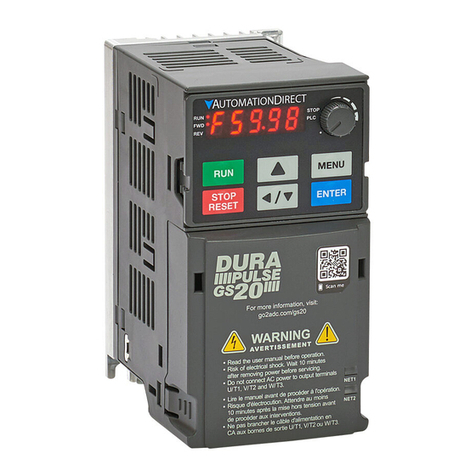
AutomationDirect
AutomationDirect DURApulse GS20 Series quick start guide
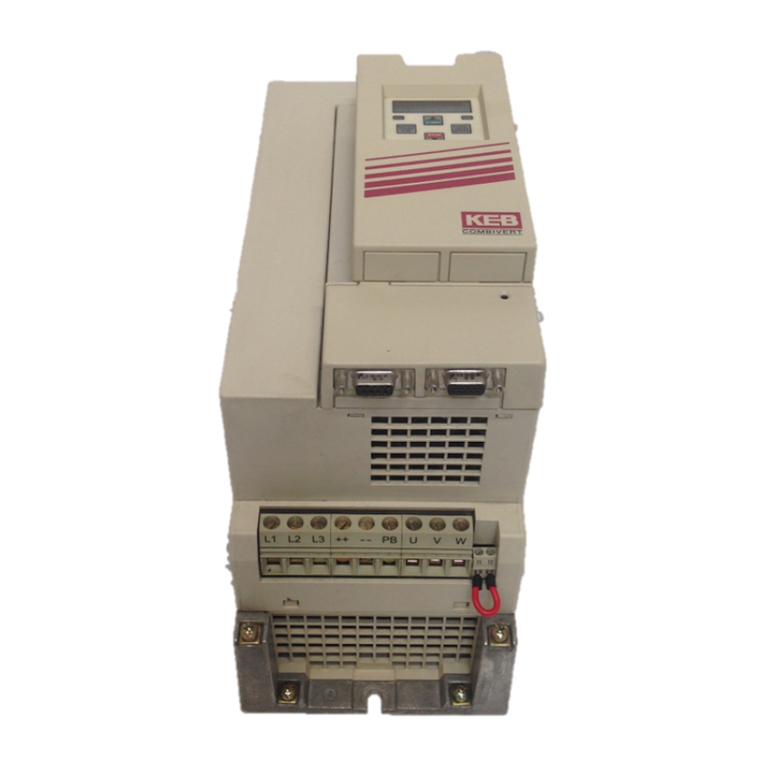
KEBCO
KEBCO COMBIVERT F5 Applications manual

Oriental motor
Oriental motor EZ limo EZS II Series operating manual
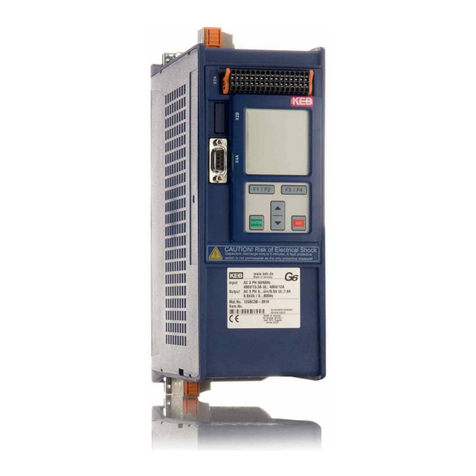
KEBCO
KEBCO COMBIVERT G6 Instructions for use and installation
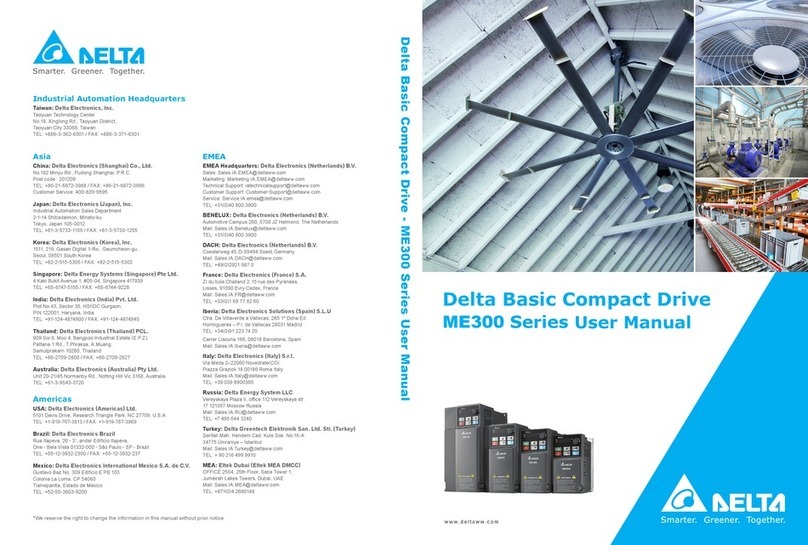
Delta
Delta ME300 Series user manual

KEBCO
KEBCO COMBIVERT F5 INSTALLATION GUIDELINE
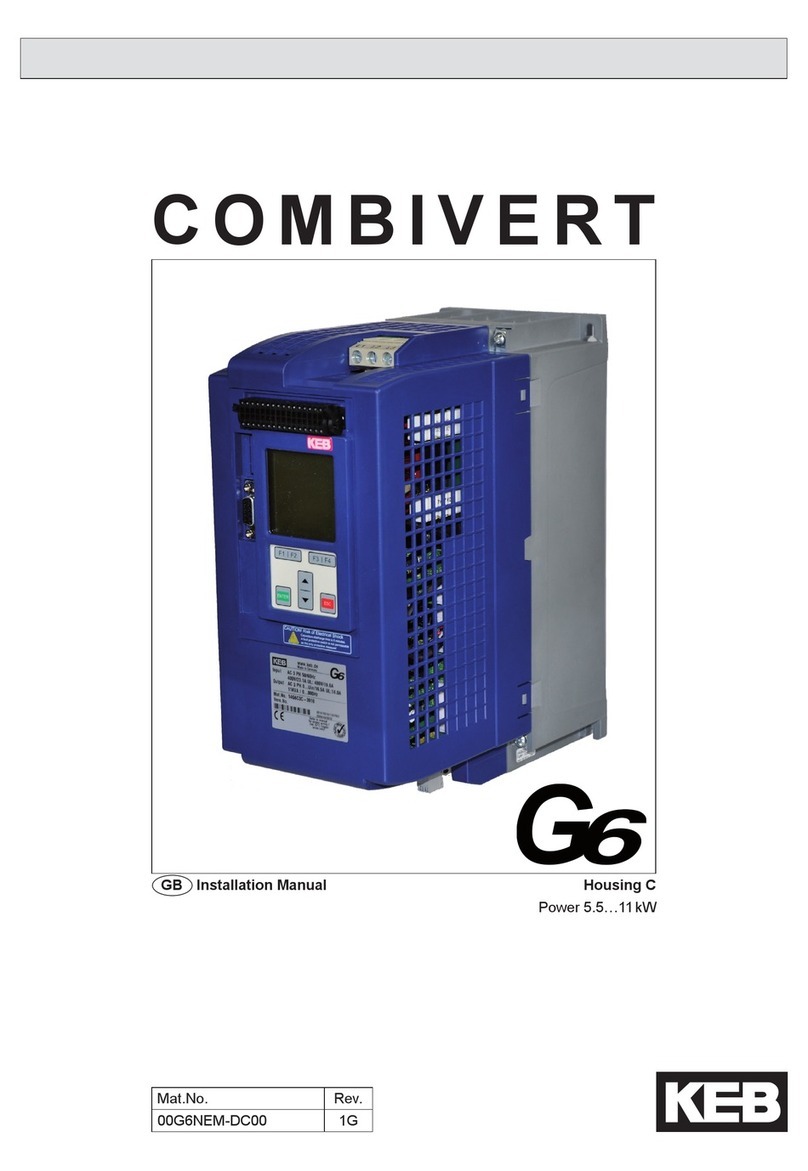
KEBCO
KEBCO COMBIVERT G6 series installation manual
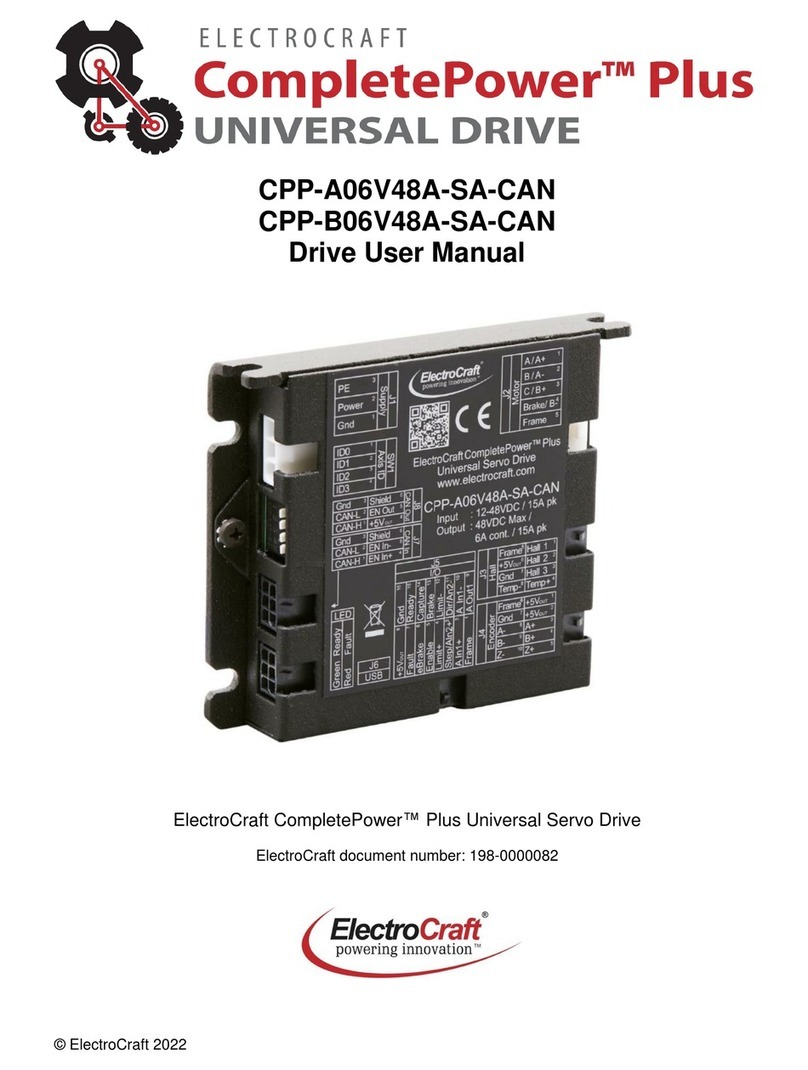
Electro-Craft
Electro-Craft CPP-A06V48A-SA-CAN user manual

Phoenix Mecano
Phoenix Mecano DEWERT OKIN DUOMAT 7 HOME installation instructions
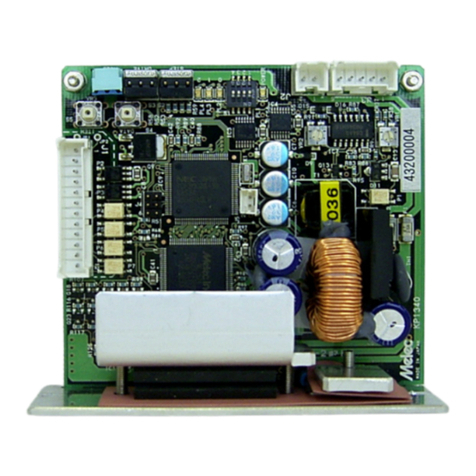
M-Elec
M-Elec GDB-5311A-00 instruction manual

Bardac
Bardac E3 Series user manual
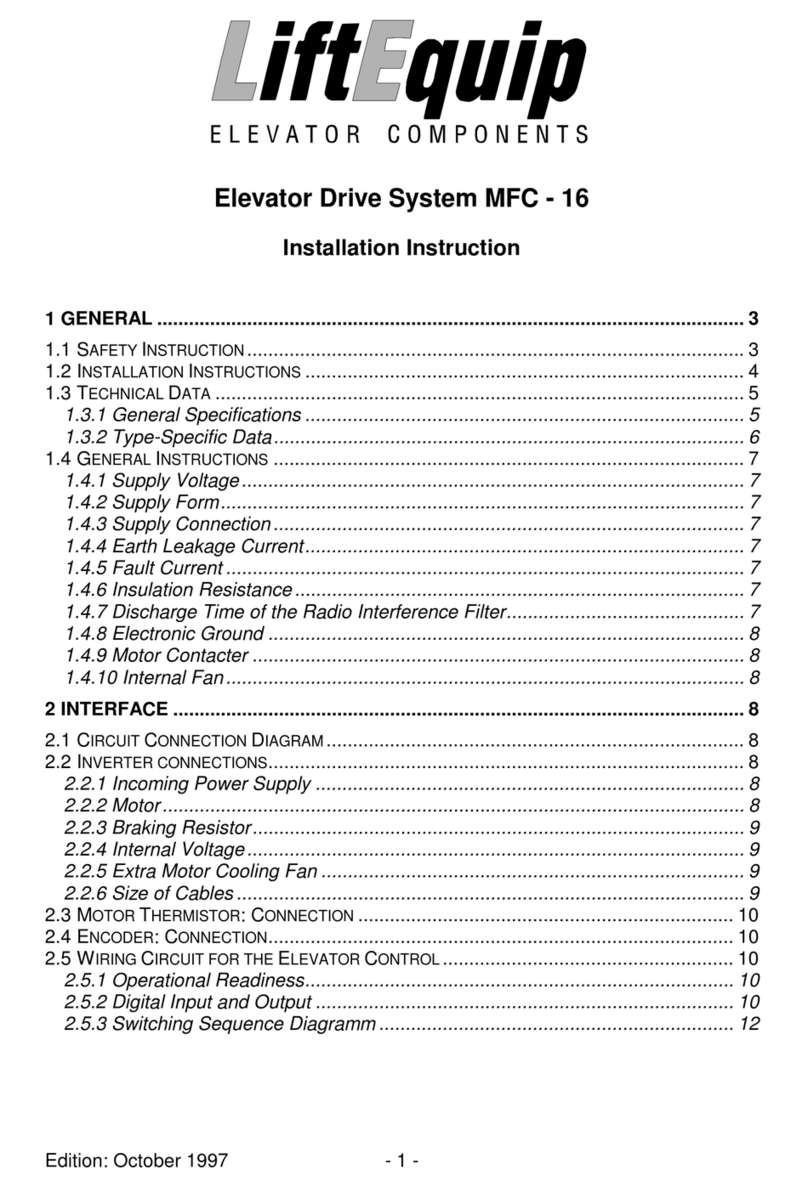
LiftEquip
LiftEquip MFC-16 Series Installation instruction

